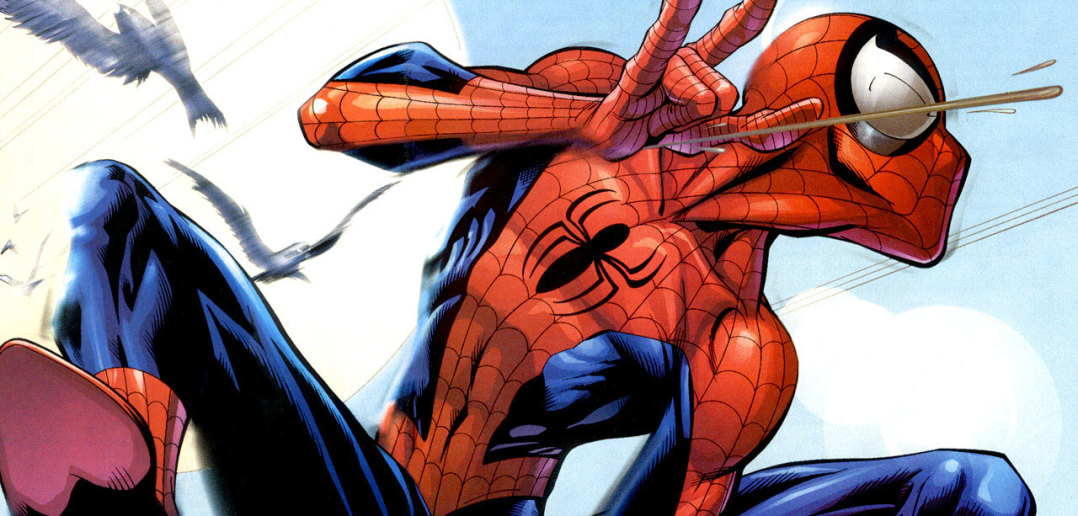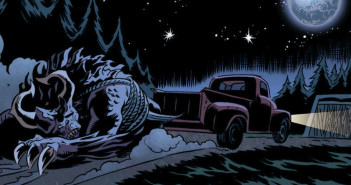Marvel experienced the beginning of a renaissance in October 2000 when Brian Michael Bendis was handed the keys to the kingdom to reinvent the character of Spider-Man. His solution was simple: he tossed out all of the old continuity and character personalities, retaining only the most primal themes and traits that defined the web-slinging hero for the 47 years he has lived in our collective imagination.
As a result, Ultimate Spider-Man began its publication, and ever since Bendis’ creation developed wild popularity; he shocked life into a franchise that desperately needed a modern spin for the younger generation of comic-book readers. With his success, a new fan base began to bud, and Marvel recognized the potential of reinventing worn-out titles for a new era of consumers.
Enter Mark Millar in February 2001 when he hopped onboard the Ultimate franchise in order to dust off the stories of The X-Men. A year later, Millar called to arms a fresh incarnation of the Avengers in his book The Ultimates. As a result, Millar accomplished in the first years of the 21st century what Alan Moore achieved in the 1980s with his legendary Watchmen story: he redefined contemporary superheroes by challenging their roles in an ever-increasingly dangerous world.
Heroics with an Attitude
As the tale of The Ultimates initially unfolded, Millar made clear that he wanted to reinvent the wheel of Steve Rogers as Captain America—with an attitude. Some titles are slow-going upon their initial publication, but not The Ultimates. It’s as if Millar is married to the very concept of momentum; the Scottish writer opened the story with a blasting clarion call of creativity and excitement, a call that wouldn’t have reached as far or as wide if not for the breathtaking illustrations of Bryan Hitch and the rich colors of Paul Mounts and Laura Martin.
The heroic team is an assembly of all the old characters we know and love, but they’re now infused with new life. Some of the key players are: Captain America, Iron Man, Thor, the Wasp, Giant Man, Quicksilver, and the Scarlet Witch. But long dead are the days when our heroes would stand with their fists mounted to their hips, staring off beyond the fourth wall with smiles etched onto their faces. The Ultimate franchise promised to rejuvenate the Avengers, and Millar took that promise to heart.
Tony Stark’s playboy lifestyle, for example, masks the sad truth that he’s suffering from a malignant brain tumor. Thor presents himself as a humanitarian, but it’s unclear if he’s of divine origins or is quite literally mad. The familial bond that connects Quicksilver and the Scarlet Witch takes on an unsettlingly incestuous dimension. And Captain America, the traditional mentor of the Marvel universe, is blurred as the limits of Steve Roger’s patriotism are challenged by his own ethnocentrism and reactionary conservatism.
The Ultimates features a host of adrenaline-pumping adventures: the dangerous containment of the Hulk, a war against the shape-shifting Chitauri, and an eventual climax no smaller than a third world war. Millar treats no material as sacred, as he uses the book as a proxy for his own views, beliefs, and worries concerning actual world affairs. And because he’s a native of Scotland, Millar’s approach towards international circumstances is one free of American influence and patriotic obligation. The end result is a more cynical band of heroes forced to face their global impact every day.
During a 2006 Word Balloon interview, the writer discussed with host John Siuntres his perception of America’s presence in the world and how it influences his writing: “Culturally, with Britain… loosing its empire, it gave us a slightly different skew in the world, and America is roughly where we were in the previous century… so you guys [Americans] have that feeling of invincibility whereas we have that feeling of fragility, knowing you can get hurt.”
Millar’s unique handling of the Ultimates and their allegorical meanings as individual heroes has resulted in what I believe to be the best superhero story told in over two decades. The Ultimates captures an honest clash between the painful realism of the world around us and the super-powered fantasy we all flee towards for a brief escape. Few understand this fine balance, but Millar is certainly one that does.
During the 2009 Big Apple Comic Con, Carlos Pacheco, Millar’s colleague and artist for Ultimate Comics: Avengers, said the following about the writer: “Mark is crazy! But Mark has a vision beyond the classical vision of superheroes, giving them new life.” I’m in no position to comment on Millar’s mental health, but I’m certain Pacheco is flawlessly correct about one thing: Millar does possess a unique vision for the future of superheroes, and his run on The Ultimates serves as proof of his priceless foresight.
Peter Parker’s Epic Journey
Teamwork isn’t the emphasis of Ultimate Spider-Man. It’s the journey of a boy becoming a man, and a man becoming a legend. Brian Michael Bendis’ work on the Spider-Man of the new millennia has refreshed the epic journey of the hero in the comic-book medium much the same way the Harry Potter series did so for children’s literature. We’re given a contemporary incarnation of Peter Parker, and with the death of his beloved Uncle Ben, his call to adventure has been sounded.
Bendis, love him or hate him (I love him), knows what he’s doing. In a 2008 interview with iFanboy, the writer spoke of his keen awareness to the symbolism of Peter Parker traveling through a Campbellian labyrinth: “All of the writers that birthed [the Ultimate franchise], and [Jeph] Loeb as well, we’re all very much Joseph Campbell and mythology students, and we’ve definitely built a mythology.”
For anyone who hasn’t read Campbell’s The Hero with a Thousand Faces, it’s the go-to volume concerning all things epic and heroic. George Lucas cited it as his primary inspiration in the creation of the original Star Wars trilogy, and is still considered a must-read in understanding world myth and the ubiquitous heroes that populate it. Peter Parker is among those heroes, as he’s certainly the “fool” if one were to apply the tarot to the Marvel universe: he stumbles into the world, rather innocent and quite naïve, and passes through an assortment of trials while meeting a host of archetypes along the way as he approaches his ultimate boon.
Each trial Spider-Man passes through is marked by the rise of a villain, and in each villain we see a reflection of the Spider-Man character if he doesn’t heed his creed: “With great power comes great responsibility.” His archnemesis, Norman Osborn as the Green Goblin, stands before Peter the same way a domineering father figure would, and only by defeating him will he be able to progress forward. This point is proven in the “Ultimate Six” story arc when Osborn refers to Peter has his true son. The same can be said for Doctor Octopus, whose maddened intelligence is a perversion of Peter’s own scientific savvy.
But the incarnation of Venom in Ultimate Spider-Man is truly something special, as Bendis presents the monster as the inverse of Spider-Man’s complete character, a kind of archetypal antithesis. The adult villains he faces are reflections, but Venom in many ways is him. It’s a creation of his late father to cure cancer that possesses Eddie Brock, Peter’s childhood friend and scientific equal. Whenever Peter is confronted by the creature, he can’t help but see the curse of a damned legacy.
It’s common in myth that a hero is guided by feminine forces, as a mother would rear a child. There are three distinct aspects of this in Ultimate Spider-Man as Peter finds guidance and influence along his own journey. Aunt May is an obvious fixture in the story, and at times her overbearing nature can hinder Peter the same way an archetypal “smothering mother” would. She’s the reason why he’s afraid to don his mask, and though she means well, throughout a great stretch of the story, she’s been somewhat of a hindrance in the development of his hero identity due to his worrying after her.
The same could be said about Mary Jane, but it doesn’t carry the same impact. M.J. knows Peter’s secret, and even more importantly, she encourages him to do what he must and even helps in small ways, such as mending his costume when it’s torn, making her a “nurturing feminine.” This role is mirrored in Gwen Stacy, though she fits into the “transformational feminine” archetype. When Gwen is first introduced, she’s somewhat androgynous in that we’re unsure of her sexuality. She displays strength before Peter, much the same way Pallas Athena displayed strength before Telemachus as he grew into a hero in the Odyssey.
Peter Parker on his journey to become Spider-Man crosses many thresholds that all heroes must cross, and there are simply too many to detail here. However, there is one of significance that deserves mention. Heroes usually embark on a journey to the underworld: Dante traveled to hell, Odysseus and Aeneus both journeyed to Hades, Orpheus crossed the River Styx in search of Eurydice. In contemporary epics, we still see this important trend. In The Empire Strikes Back, Luke Skywalker climbed into the cave rich with the dark side’s energies. In The Lord of the Rings, the fellowship descended into Moria where they faced an ancient devil. The dying Grace Augustine in Avatar is taken to the Tree of Souls in an attempt to resurrect her.
The eleventh volume of Ultimate Spider-Man, “Carnage,” is the most hellish of all the arcs in the story. Carnage himself appears to be a devil, claiming numerous lives. The colors of the book are heavy reds and deep blacks, signifying an unforgiving darkness and ever-present death. And as Peter himself descends into the underworld created by Carnage, he learns a valuable lesson. For that’s the purpose of these journeys to the other side: they impart knowledge, pass down wisdom, and sometimes teach the most difficult lessons in life. Gwen’s death causes Peter to truly question his role in the world, which is something we all must do at some point in order to grow and advance in life.
Because Ultimate Spider-Man is a comic book, it’s constantly expanding and changing from month to month. Unlike in a contained story that sets its agenda and sees it through, the archetypes here will change. Aunt May now knows Peter is Spider-Man. Gwen has returned from the dead and is now in a relationship with the web-slinger. But their original impact still remains true, because they have catalogued the development of a hero as he progresses through his life. And in turn, when we look at him, perhaps we see some of the developments we’ve made in our own lives, too.
This essay was originally published by the Frontiersman. To view the PDF version of the piece’s original publication, please click here.




